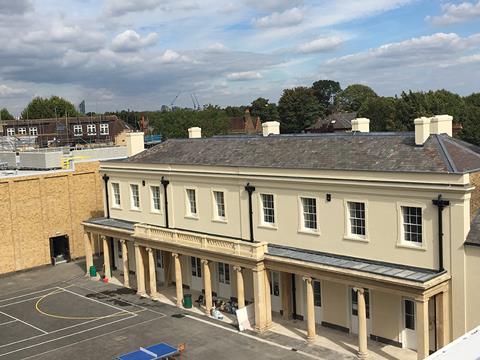- News

All the latest updates on building safety reformRegulations latest
- Focus
- Home
- News
- Focus
- Comment
- Events
- CPD
- Building the Future
- Jobs
- Data
- Subscribe
- Building Boardroom
Cost model: School buildings
By Sarah Crowley, Peter Robinson and Jeff Simmonds 2020-10-30T05:00:00

Demand for school buildings is rising in the UK, but with land and funding at a premium, those tasked with making safe, inspiring educational spaces face tough limitations. Aecom’s Sarah Crowley, Peter Robinson and Jeff Simmonds examine the schools building sector and offer a cost breakdown

At Ealing Fields High School in London, a new-build element – featuring a science lab and a cafe area – was integrated into a refurbishment project on its main building, a 17th-century listed structure
01 / Introduction
As the UK population rises, so too does demand for school places. State school building stock is growing, but not fast enough: across school types, there is expected to be a need for at least 420,000 more school places by 2021.
Most of this increase in pupil numbers is to be found at primary school level. The number of pupils across all school types rose by 110,000 between 2016 and 2017 alone, with 74,500 of these pupils entering primary schools, according to a report by AMA Research.
In England, on which this cost model is focused, there were 50 million m2 of state-maintained school buildings, across 22,616 schools at the government’s last official count. That figure has increased significantly since 2013, when the count was taken. There was a 46% leap in education construction between 2013 and 2017, according to AMA Research.
Such a rise in construction activity sounds encouraging, but since 2017 building output has dropped. Education construction shrank by 8% in 2018, in line with state funding cuts to the sector. The following year saw a similar downwards trend, and construction output in 2020 has of course been hit by covid-19 restrictions and site closures.
Schools across England are therefore facing growing student numbers, with falling construction activity to accommodate these additional pupils.
Read more…
This is PREMIUM content
available to Building Boardroom and Building subscribers only
You are not currently logged in. Building Boardroom Members and Subscribers may LOGIN here.
Become a Building Boardroom Member

to read this report now, plus have unlimited access to:
- Exclusive research and client insight to support your strategic planning
- Benchmark reports, and proven tools to aid your business development
- Attend bespoke community events…plus much more
Alternatively…
Become a Building subscriber
to gain access to building.co.uk for the latest news, expert analysis & comment from industry leaders, plus data and research.
Already a Boardroom member? Log in here.


















